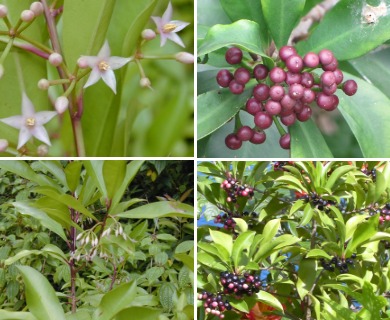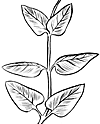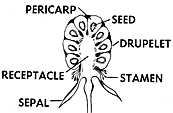Shoebutton
Ardisia elliptica
Primrose family (Primulaceae)
Post-Cook introduction
Introduced shrub or small tree with elliptical leathery leaves and many small pinkish starlike flowers, ornamental and becoming naturalized in moist lowland areas. To 20 ft (6 ) high and 3 inches (7.5 ) in trunk diameter. Twigs slightly stout, light green, purplish tinged, hairless.

Forest And Kim Starr
Flower clusters () at base of upper leaves, 1 1⁄2–3 inches (4–7.5 ) long, branched. Flowers many on slender green talks of about 1⁄2 inch (13 ), from pointed pink bud 3⁄8 inch (1 ) long, spreading starlike, composed of cuplike with five rounded whitish with brown dots; with five from short tube spreading starlike about 1⁄2 inch (13 ) wide, pink with brown dots; five inserted near base of with large long-pointed brown united; and with round greenish containing many ovules and with a slender whitish
() many, rounded, becoming 3⁄8 inch (1 ) in diameter, slightly flattened, turning from pink to black, with -dots, and base of remaining, with purplish juice. Seed single, round.
Heartwood is pale brown with large conspicuous darker colored showing prominently on all surfaces. Of moderate density and hardness, with a fine texture; not used.
Planted as an ornamental for the pretty flowers and glossy leaves but escaping and becoming naturalized as a weed in moist lowland areas, especially Oahu, Maui, and Hawaii.
Special area
Waimea Arboretum
Range
Native of southeastern Asia. Widely cultivated through the tropics and becoming naturalized. Introduced and naturalized locally in south Florida.
Other common name
elliptical-leaf ardisia
Botanical
Ardisia solanacea Roxb., A. humilis auth., not Vahl.
The common name apparently refers to the resemblance of the round blackish to buttons formerly worn on ladies’ high-topped shoes.









